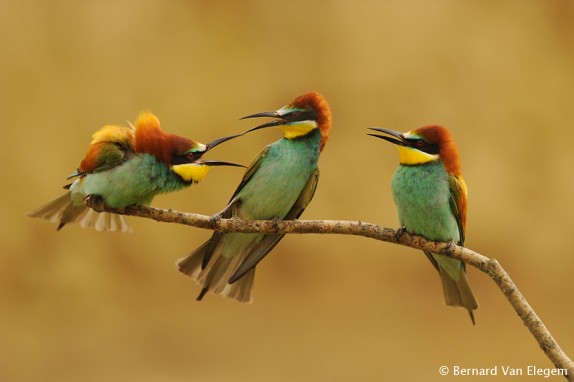- 1 of 188
- next
Quarrel of European Bee-eaters - Geruzie onder Bijeneters - Merops apiaster
Bee-eaters are colony breeders and thus have more sophisticated social relationships in comparison to many other species. These relationships are important when living close together on a very small surface. During an entire morning at a Bee-eater colony I could observe the classical behaviour of these birds during the mating and breeding season. As soon as it started to warm up and the insects became active, the birds flew out of their nests to go foraging. Others were still carving out their nests in the steep loamy sandbank. Each time a Bee-eater meets his partner on a perch, a short kind of greeting ceremony takes place: both birds perch then upright, call excitedly, and fan and vibrate their tail. Mating also regularly took place, on the ground or on a perch. A very brief courtship precedes the mating: the male offers an insect to the female, then he puts his wing tenderly around the female. The following moments appear rather brutal to us, when the male hits the female's head quickly and quite violently with his bill. This is soon followed by the mating. All the above mentioned social behaviour is related to the pair bonding. But during about five minutes, I witnessed a kind of spectacle in which many pairs were involved. It seemed very similar to the greeting ceremony of a pair, but then with tens of pairs involved on all the perches in the close vicinity of the colony. It started with the excitedly calling of several flying pairs. A few moments later several pairs landed very close to each other on the perches. The birds then started to stretch out and perch upright, while calling vigorously. Very often they chased away a bird on a perch or quarrelled with their neighbour on the perch. Sometimes it looked like a simultaneous choreography of two pairs, but more often there seemed to be a small dispute between some of the birds. The behaviour lasted for a few minutes and then stopped as sudden and unexpectedly as it had started. The exact meaning of this brief and intense spectacle remains unknown to me, but I guess it' s part of the complex social behaviour of these colony-breeders.

